Charles Dickens
A Mathematical Framework, a Taxonomy of Modeling Paradigms, and a Suite of Learning Techniques for Neural-Symbolic Systems
Jul 12, 2024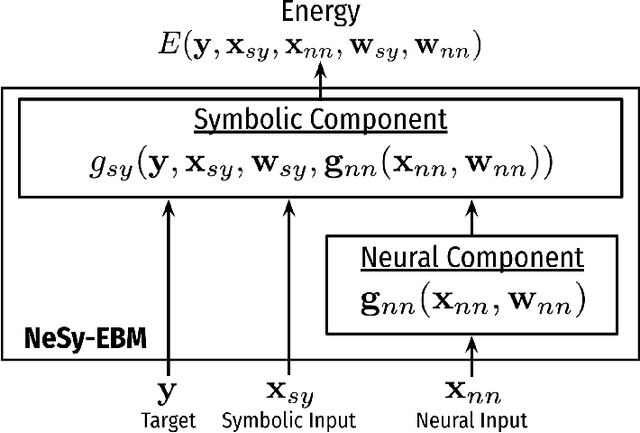

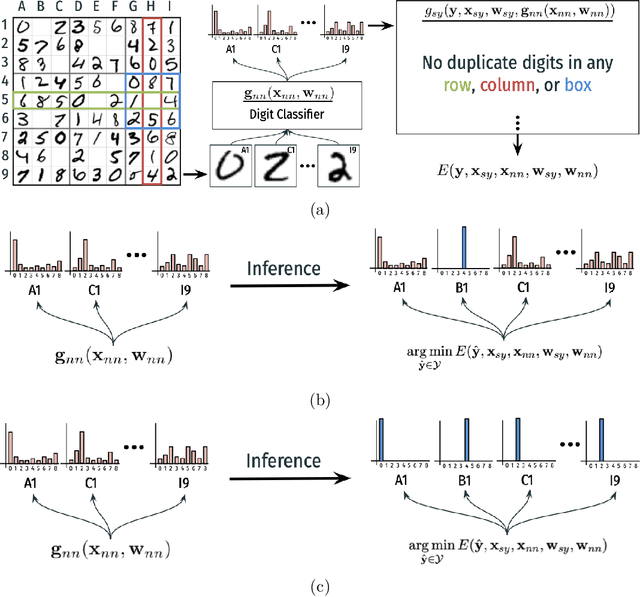

Abstract:The field of Neural-Symbolic (NeSy) systems is growing rapidly. Proposed approaches show great promise in achieving symbiotic unions of neural and symbolic methods. However, each NeSy system differs in fundamental ways. There is a pressing need for a unifying theory to illuminate the commonalities and differences in approaches and enable further progress. In this paper, we introduce Neural-Symbolic Energy-Based Models (NeSy-EBMs), a unifying mathematical framework for discriminative and generative modeling with probabilistic and non-probabilistic NeSy approaches. We utilize NeSy-EBMs to develop a taxonomy of modeling paradigms focusing on a system's neural-symbolic interface and reasoning capabilities. Additionally, we introduce a suite of learning techniques for NeSy-EBMs. Importantly, NeSy-EBMs allow the derivation of general expressions for gradients of prominent learning losses, and we provide four learning approaches that leverage methods from multiple domains, including bilevel and stochastic policy optimization. Finally, we present Neural Probabilistic Soft Logic (NeuPSL), an open-source NeSy-EBM library designed for scalability and expressivity, facilitating real-world application of NeSy systems. Through extensive empirical analysis across multiple datasets, we demonstrate the practical advantages of NeSy-EBMs in various tasks, including image classification, graph node labeling, autonomous vehicle situation awareness, and question answering.
Convex and Bilevel Optimization for Neuro-Symbolic Inference and Learning
Jan 17, 2024Abstract:We address a key challenge for neuro-symbolic (NeSy) systems by leveraging convex and bilevel optimization techniques to develop a general gradient-based framework for end-to-end neural and symbolic parameter learning. The applicability of our framework is demonstrated with NeuPSL, a state-of-the-art NeSy architecture. To achieve this, we propose a smooth primal and dual formulation of NeuPSL inference and show learning gradients are functions of the optimal dual variables. Additionally, we develop a dual block coordinate descent algorithm for the new formulation that naturally exploits warm-starts. This leads to over 100x learning runtime improvements over the current best NeuPSL inference method. Finally, we provide extensive empirical evaluations across $8$ datasets covering a range of tasks and demonstrate our learning framework achieves up to a 16% point prediction performance improvement over alternative learning methods.
Graph Coarsening via Convolution Matching for Scalable Graph Neural Network Training
Dec 24, 2023



Abstract:Graph summarization as a preprocessing step is an effective and complementary technique for scalable graph neural network (GNN) training. In this work, we propose the Coarsening Via Convolution Matching (CONVMATCH) algorithm and a highly scalable variant, A-CONVMATCH, for creating summarized graphs that preserve the output of graph convolution. We evaluate CONVMATCH on six real-world link prediction and node classification graph datasets, and show it is efficient and preserves prediction performance while significantly reducing the graph size. Notably, CONVMATCH achieves up to 95% of the prediction performance of GNNs on node classification while trained on graphs summarized down to 1% the size of the original graph. Furthermore, on link prediction tasks, CONVMATCH consistently outperforms all baselines, achieving up to a 2x improvement.
Simplifying Distributed Neural Network Training on Massive Graphs: Randomized Partitions Improve Model Aggregation
May 17, 2023



Abstract:Distributed training of GNNs enables learning on massive graphs (e.g., social and e-commerce networks) that exceed the storage and computational capacity of a single machine. To reach performance comparable to centralized training, distributed frameworks focus on maximally recovering cross-instance node dependencies with either communication across instances or periodic fallback to centralized training, which create overhead and limit the framework scalability. In this work, we present a simplified framework for distributed GNN training that does not rely on the aforementioned costly operations, and has improved scalability, convergence speed and performance over the state-of-the-art approaches. Specifically, our framework (1) assembles independent trainers, each of which asynchronously learns a local model on locally-available parts of the training graph, and (2) only conducts periodic (time-based) model aggregation to synchronize the local models. Backed by our theoretical analysis, instead of maximizing the recovery of cross-instance node dependencies -- which has been considered the key behind closing the performance gap between model aggregation and centralized training -- , our framework leverages randomized assignment of nodes or super-nodes (i.e., collections of original nodes) to partition the training graph such that it improves data uniformity and minimizes the discrepancy of gradient and loss function across instances. In our experiments on social and e-commerce networks with up to 1.3 billion edges, our proposed RandomTMA and SuperTMA approaches -- despite using less training data -- achieve state-of-the-art performance and 2.31x speedup compared to the fastest baseline, and show better robustness to trainer failures.
Emotion Recognition in Conversation using Probabilistic Soft Logic
Jul 14, 2022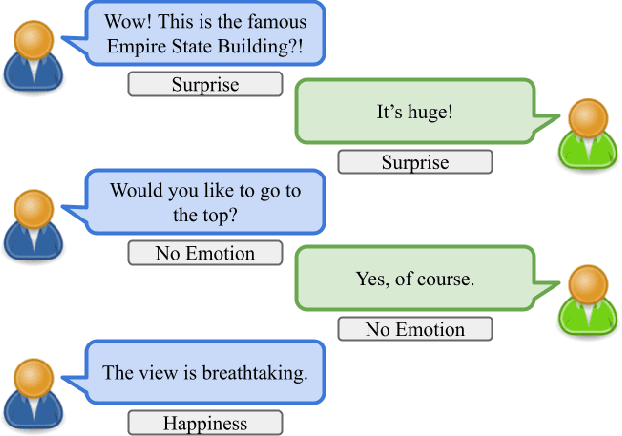


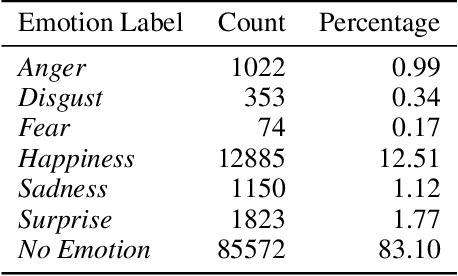
Abstract:Creating agents that can both appropriately respond to conversations and understand complex human linguistic tendencies and social cues has been a long standing challenge in the NLP community. A recent pillar of research revolves around emotion recognition in conversation (ERC); a sub-field of emotion recognition that focuses on conversations or dialogues that contain two or more utterances. In this work, we explore an approach to ERC that exploits the use of neural embeddings along with complex structures in dialogues. We implement our approach in a framework called Probabilistic Soft Logic (PSL), a declarative templating language that uses first-order like logical rules, that when combined with data, define a particular class of graphical model. Additionally, PSL provides functionality for the incorporation of results from neural models into PSL models. This allows our model to take advantage of advanced neural methods, such as sentence embeddings, and logical reasoning over the structure of a dialogue. We compare our method with state-of-the-art purely neural ERC systems, and see almost a 20% improvement. With these results, we provide an extensive qualitative and quantitative analysis over the DailyDialog conversation dataset.
NeuPSL: Neural Probabilistic Soft Logic
May 27, 2022



Abstract:We present Neural Probabilistic Soft Logic (NeuPSL), a novel neuro-symbolic (NeSy) framework that unites state-of-the-art symbolic reasoning with the low-level perception of deep neural networks. To explicitly model the boundary between neural and symbolic representations, we introduce NeSy Energy-Based Models, a general family of energy-based models that combine neural and symbolic reasoning. Using this framework, we show how to seamlessly integrate neural and symbolic parameter learning and inference. We perform an extensive empirical evaluation and show that NeuPSL outperforms existing methods on joint inference and has significantly lower variance in almost all settings.
HyperFair: A Soft Approach to Integrating Fairness Criteria
Sep 05, 2020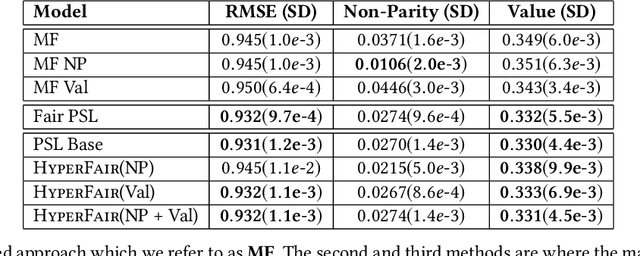

Abstract:Recommender systems are being employed across an increasingly diverse set of domains that can potentially make a significant social and individual impact. For this reason, considering fairness is a critical step in the design and evaluation of such systems. In this paper, we introduce HyperFair, a general framework for enforcing soft fairness constraints in a hybrid recommender system. HyperFair models integrate variations of fairness metrics as a regularization of a joint inference objective function. We implement our approach using probabilistic soft logic and show that it is particularly well-suited for this task as it is expressive and structural constraints can be added to the system in a concise and interpretable manner. We propose two ways to employ the methods we introduce: first as an extension of a probabilistic soft logic recommender system template; second as a fair retrofitting technique that can be used to improve the fairness of predictions from a black-box model. We empirically validate our approach by implementing multiple HyperFair hybrid recommenders and compare them to a state-of-the-art fair recommender. We also run experiments showing the effectiveness of our methods for the task of retrofitting a black-box model and the trade-off between the amount of fairness enforced and the prediction performance.
 Add to Chrome
Add to Chrome Add to Firefox
Add to Firefox Add to Edge
Add to Edge